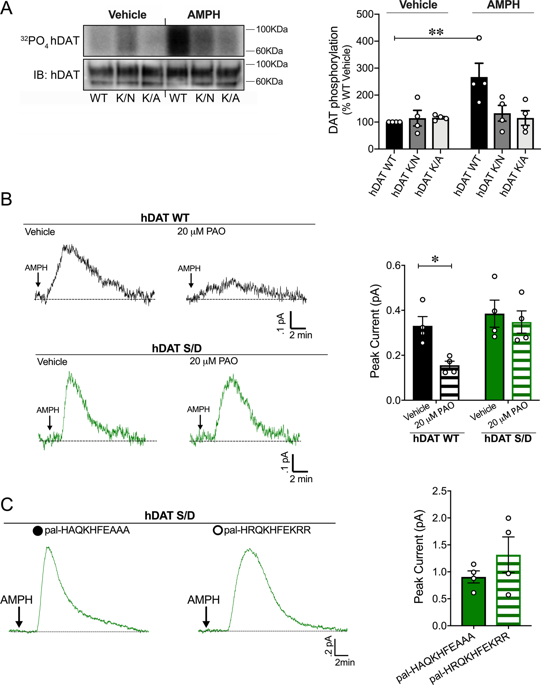当前位置:
X-MOL 学术
›
Mol. Psychiatry
›
论文详情
Our official English website, www.x-mol.net, welcomes your
feedback! (Note: you will need to create a separate account there.)
A network of phosphatidylinositol (4,5)-bisphosphate (PIP2) binding sites on the dopamine transporter regulates amphetamine behavior in Drosophila Melanogaster.
Molecular Psychiatry ( IF 9.6 ) Pub Date : 2019-12-03 , DOI: 10.1038/s41380-019-0620-0 Andrea N Belovich 1 , Jenny I Aguilar 2, 3 , Samuel J Mabry 3 , Mary H Cheng 4 , Daniele Zanella 3 , Peter J Hamilton 5 , Daniel J Stanislowski 6 , Aparna Shekar 2, 3 , James D Foster 6 , Ivet Bahar 4 , Heinrich J G Matthies 3 , Aurelio Galli 3
Molecular Psychiatry ( IF 9.6 ) Pub Date : 2019-12-03 , DOI: 10.1038/s41380-019-0620-0 Andrea N Belovich 1 , Jenny I Aguilar 2, 3 , Samuel J Mabry 3 , Mary H Cheng 4 , Daniele Zanella 3 , Peter J Hamilton 5 , Daniel J Stanislowski 6 , Aparna Shekar 2, 3 , James D Foster 6 , Ivet Bahar 4 , Heinrich J G Matthies 3 , Aurelio Galli 3
Affiliation

|
Reward modulates the saliency of a specific drug exposure and is essential for the transition to addiction. Numerous human PET-fMRI studies establish a link between midbrain dopamine (DA) release, DA transporter (DAT) availability, and reward responses. However, how and whether DAT function and regulation directly participate in reward processes remains elusive. Here, we developed a novel experimental paradigm in Drosophila melanogaster to study the mechanisms underlying the psychomotor and rewarding properties of amphetamine (AMPH). AMPH principally mediates its pharmacological and behavioral effects by increasing DA availability through the reversal of DAT function (DA efflux). We have previously shown that the phospholipid, phosphatidylinositol (4, 5)-bisphosphate (PIP2), directly interacts with the DAT N-terminus to support DA efflux in response to AMPH. In this study, we demonstrate that the interaction of PIP2 with the DAT N-terminus is critical for AMPH-induced DAT phosphorylation, a process required for DA efflux. We showed that PIP2 also interacts with intracellular loop 4 at R443. Further, we identified that R443 electrostatically regulates DA efflux as part of a coordinated interaction with the phosphorylated N-terminus. In Drosophila, we determined that a neutralizing substitution at R443 inhibited the psychomotor actions of AMPH. We associated this inhibition with a decrease in AMPH-induced DA efflux in isolated fly brains. Notably, we showed that the electrostatic interactions of R443 specifically regulate the rewarding properties of AMPH without affecting AMPH aversion. We present the first evidence linking PIP2, DAT, DA efflux, and phosphorylation processes with AMPH reward.
中文翻译:

多巴胺转运蛋白上的磷脂酰肌醇 (4,5)-二磷酸 (PIP2) 结合位点网络调节黑腹果蝇的苯丙胺行为。
奖励调节特定药物暴露的显着性,对于过渡到成瘾至关重要。许多人类 PET-fMRI 研究建立了中脑多巴胺 (DA) 释放、DA 转运蛋白 (DAT) 可用性和奖励反应之间的联系。然而,DAT 功能和监管如何以及是否直接参与奖励过程仍然难以捉摸。在这里,我们在黑腹果蝇中开发了一种新的实验范式,以研究安非他明 (AMPH) 的精神运动和奖励特性的潜在机制。AMPH 主要通过逆转 DAT 功能(DA 流出)增加 DA 可用性来介导其药理和行为效应。我们之前已经表明,磷脂、磷脂酰肌醇 (4, 5)-二磷酸 (PIP2)、直接与 DAT N 末端相互作用以支持 DA 流出以响应 AMPH。在这项研究中,我们证明 PIP2 与 DAT N 末端的相互作用对于 AMPH 诱导的 DAT 磷酸化至关重要,这是 DA 流出所需的过程。我们发现 PIP2 还与 R443 处的细胞内环 4 相互作用。此外,我们发现 R443 静电调节 DA 流出作为与磷酸化 N 末端协调相互作用的一部分。在果蝇中,我们确定 R443 的中和取代抑制了 AMPH 的精神运动作用。我们将这种抑制与 AMPH 诱导的 DA 外流减少相关联。值得注意的是,我们发现 R443 的静电相互作用特异性地调节 AMPH 的奖励特性而不影响 AMPH 厌恶。
更新日期:2019-12-04
中文翻译:

多巴胺转运蛋白上的磷脂酰肌醇 (4,5)-二磷酸 (PIP2) 结合位点网络调节黑腹果蝇的苯丙胺行为。
奖励调节特定药物暴露的显着性,对于过渡到成瘾至关重要。许多人类 PET-fMRI 研究建立了中脑多巴胺 (DA) 释放、DA 转运蛋白 (DAT) 可用性和奖励反应之间的联系。然而,DAT 功能和监管如何以及是否直接参与奖励过程仍然难以捉摸。在这里,我们在黑腹果蝇中开发了一种新的实验范式,以研究安非他明 (AMPH) 的精神运动和奖励特性的潜在机制。AMPH 主要通过逆转 DAT 功能(DA 流出)增加 DA 可用性来介导其药理和行为效应。我们之前已经表明,磷脂、磷脂酰肌醇 (4, 5)-二磷酸 (PIP2)、直接与 DAT N 末端相互作用以支持 DA 流出以响应 AMPH。在这项研究中,我们证明 PIP2 与 DAT N 末端的相互作用对于 AMPH 诱导的 DAT 磷酸化至关重要,这是 DA 流出所需的过程。我们发现 PIP2 还与 R443 处的细胞内环 4 相互作用。此外,我们发现 R443 静电调节 DA 流出作为与磷酸化 N 末端协调相互作用的一部分。在果蝇中,我们确定 R443 的中和取代抑制了 AMPH 的精神运动作用。我们将这种抑制与 AMPH 诱导的 DA 外流减少相关联。值得注意的是,我们发现 R443 的静电相互作用特异性地调节 AMPH 的奖励特性而不影响 AMPH 厌恶。











































 京公网安备 11010802027423号
京公网安备 11010802027423号